NAGANO

Onsen in the Nagano area Nagano (1½ hours by bullet train from Tokyo) hosted the Winter Olympics in 1998. Founded in the 12th century, Nagano City is a modern Japanese city with 360,000 people. Some of the Olympic events were held in the city itself. Others were held at facilities outside Nagano. A new shinkansen that opened before the Olympics was built at considerable expense to move people quickly from Tokyo ro Nagano
Nagano Prefecture covers 13,104 square kilometers (5060 square miles), is home to about two million people and has a population density of 155 people per square kilometer. Nagano is the capital and largest city, with about 378,000 people. It is in Chubu in central Honshu island and has 14 districts and 77 municipalities. Most of the Japan Alps are located within Nagano prefecture, which is famous soba noodles, hot spring resorts, undeveloped towns, and working farms.
Matsushiro Headquarters (in Nagano) is perhaps the most interesting place to visit in the Nagano area. It is a huge network of tunnels built for the Emperor and top government officials at the end of World War II. Big enough to drive through, the tunnels were built by Korean forced laborers, 300 to 1,000 of whom died. Most of the seven miles of tunnels are closed to visitors. Each year the site attracts around 130,000 visitors with about a fifth of them being students. Website: Wikipedia http://en.wikipedia.org/wiki/Matsushiro_Underground_Imperial_Headquarters
Websites: Nagano Prefecture site Go Nagano Maps: myoko-nagano.com Ryokan and Minshuku Japanese Guest Houses Japanese Guest Houses Budget Accommodation: Japan Youth Hostels Japan Youth Hostels Check Lonely Planet books Getting There: Nagano is accessible by air and by bus and by train from several Japanese cities. It is only 90 minutes away from Tokyo by shinkansen. Lonely Planet Lonely Planet
Zenkoji Temple
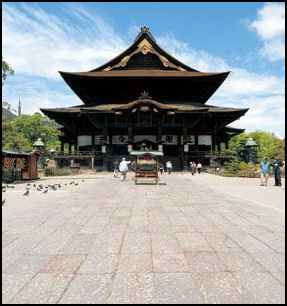
Zenkoji Temple (1 mile from Nagano Station) contains one old Japan's oldest Buddhas. Brought to Japan from Korea in A.D. 552 and known as the Amitabha, it is gilded bronze statue that is said to have such strong miraculous powers that it must be kept hidden away lest anyone become injured or blinded by it. Other than a pair of tenants who take care of it, the statue has not beeen seen for 305 years. Even the Emperor can't view it. Models of the Amitabha have been made. But even these are only shown once every six years.
Zenkoji attracts pilgrims from all over Japan. Many of them as well as ordinary people descend into a dark tunnel under the temple’s main hall and grope for a key to salvation that is supposed to bring good fortune and enlightenment to anyone who touches it. The temple has a reputation for being especially welcoming to women. Visitors are allowed to attend morning rites and have their head touched with the prayer beads of a monk.
The original temple was built in the 7th century. Today, Zenkoji contains 40 buildings, and a 332-year-old bell. The main hall is one of the largest wooden temples in Japan. The structure was erected in 1707. Website: Wikipedia Wikipedia
Around Nagano
Togakushi is a popular starting points for hikes of Mt, Menoyama and Mt. Kurohime-yama. Obuse (30-minute drive from Nagano) is the home of the Hokusia Museum, with works by Hokusia, one of Japan's most famous artists. The museum has a splendid collection of works by the legendary ukiyo-e (Japanese woodblock) artist.
Hakusan National Park is home of Mt. Haku, one of the three most sacred peaks in Japan along with Mt. Fuji. The three main peaks of Mt. Haku — Gozen, Onanji and Kengamine — are each over 8,000 feet high. There are also beautiful primeval forests and a wide variety of Alpine vegetation. Website: Government National Park Site National Parks of Japan Lonely Planet Lonely Planet ; Getting There: Lonely Planet Lonely Planet
Hot Springs around Nagano include Sensi Onsen and Nozawa Onsen (with 13 major hot spring facilities). Kaminoyu (the "Bath of the God") has several mineral springs: the coolest is 118̊F and the hottest is 172̊F.
Nagano Olympic Venues
The figure skating and speed skating events were held at the "White Ring" arena in Moshima, about four miles from the Olympic Village. With a futuristic dewdrop-shaped sloping roof, the indoor rink measures 60-x-30 meters and can seat 7,300 spectators. The hockey and short track speed skating events were also held in Nagano city. The bobsled and luge events were held on the tracks in Asakawa in Iizuna Kogen. The 1,360 meter, 15-curve course is nicknamed the Spiral. It I the first of its kind to be built in the side of mountains and have two uphill sections. The freestyle skiing events were held nearby
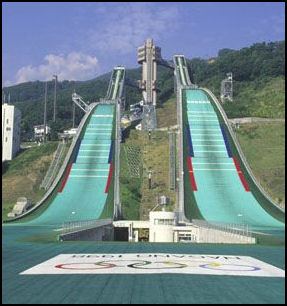
Olympic ski jump Yamanouchi (in Shiga Kogen, 28 kilometers northeast of Nagano) hosted the snowboard giant slalom and the snowboard half pike events at the 1998 Winter Olympic. The men and women's snowboard giant slalom events were held at Mt. Yakebitai and the snowboard half pike was held at Kanbayashi snowboard park.
Happo'one Ski Area (near Hakuba) hosted the men’s and women's downhill, Super-G and combined slalom events at the 1998 Winter Olympics. Situated on the eastern foothills of Mt. Karamatsudake, the ski area attracts 2.6 million skiers annually and is known for it's long challenging runs. In the summer it attracts many hikers intent on climbing 2,696-meter-high Mt. Karamatsi-dake. Website: Snow Japan snowjapan.com
Snow Harp (near Hakuba) hosted the cross-country skiing events at the 1998 Winter Olympics. There were three different Olympic courses that could be set up for routes ranging in length from 5 kilometers to 50 kilometers in length. Nozawa Onsen hosted the biathlon events.
Shiga Kogen is one of Japan's largest ski areas with 21 resorts and 80 runs.
Websites: Snow Japan snowjapan.com Map: Japan Ski skijapan.com
Hakuba
Hakuba (25 miles east of Nagano) lies a the center of one of Japan's premier skiing areas. A tiny village of only 9,000 people, it hosted the ski jumping, Alpine skiing, Nordic skiing, and Nordic combined events at the 1998 Winter Olympics.
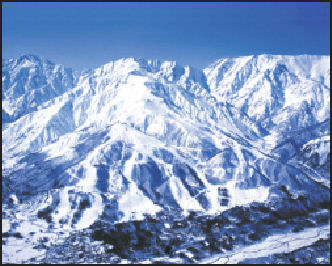
Hakuba The jumping events were held on the 120-meter and 90-meters parallel jumps at Hakuna Ski Jumping Stadium. A unique turret design was adapted for both the in run and outrun, and special features include snow making equipment that allows the facility to be used throughout much of the year.
Hakuba refers to the town and the 9,619-foot mountain. About 3.7 million skiers, hikers and hot springs lovers visit Hakuba every year. Popular hiking destinations include Mt. Shirouma-dake, Great Snowy Gorge, Yari Onsen (an open air onsen with mountain views) and Tsugaike National Park. Businesses in Hakuba include the Magic Mushroom surf shop, Groovey At Space hair salon, Shop Jaha Jah and the Tijuana Café.
Websites: Hakuba Tourism hakubatourism.com ; Snow Japan snowjapan.com Maps: Hakuba Travel hakubatravel.com ; Budget Accommodation: Japan Youth Hostels Japan Youth Hostels Check Lonely Planet books Getting There: Hakuba is one hour by train from Matsumoto and connected to other cities by train. Lonely Planet Lonely Planet
Bath-Taking Monkeys of Jigokudani
Yudanaka (in Yamanouchi Town in Nagano Prefecture, 40 kilometers northeast of Nagano City ) is the home of Jigokudani (Hell Valley). Located in a steep-sided valley on the western flanks of the Shigakogen highlands, Jigokudani means "hell valley," a reference to the large number of volcanic vents and hot springs in the area. Jigokudani hot springs are known for their wild Japanese macaque monkeys. Active throughout most of the year, the monkeys are known worldwide as 'snow monkeys' for bathing in the hot springs during the winter. The sight is enjoyed by large numbers of tourists.
Ben Crair wrote in Smithsonian magazine: “The “Snow Monkey Express” was almost empty when I rode with a few other tourists from Nagano to the last stop in Yamanouchi, a town of 12,400. A banner welcomed us to the “Snow Monkey Town,” and signs in the station showed red-faced Japanese macaques soaking up to their necks in hot-spring water. The monkeys closed their eyes and stretched their arms as steam rose around them and snowflakes settled in the dry fur on their heads.[Source: Ben Crair, Smithsonian magazine, January-February 2021]
The next morning, I walked several miles through the forest to the Jigokudani Monkey Park, where a sign for a “monkey onsen” pointed over a footbridge. The pool steamed on the edge of a cliff over the Yokoyu River, and a single monkey sat at its center, an old female with a long muzzle and round amber eyes. She was one of about 40 macaques who sometimes used the bath. Other monkeys were squabbling over the grain that workers at the monkey park had spread on the riverbank and mountainside.
“The photos I’d seen before the trip gave an impression of relaxed little animals, but the scene was anything but Zen. Scientists describe Japanese macaque societies as “despotic” and “nepotistic.” Every monkey in a given group had a place in a linear dominance hierarchy, one for males and one for females, and they constantly displaced inferiors to reinforce their rank. The monkeys were vigilant as they picked grain from the snow, constantly looking over their shoulders to keep tabs on their neighbors: A higher-ranking monkey might drag them by the leg or sink its teeth into their neck.
“As mealtime wound down, the monkeys began to groom each other — their way to not only eliminate parasites but also placate a superior or form an alliance. A few juveniles jumped into the onsen, while adult females waded in more carefully. I crouched in front of a female macaque, who gripped a rock with both hands and plunged her hindquarters underwater. Her adolescent son squatted behind her while her infant daughter paddled by her side. The son combed through her fur, first with his left hand and then his right, working through her gray undercoat to the white skin and eating the morsels he found inside. The mother closed her bluish eyelids and rested her red cheek on the rock between her hands. Her name was Tomiko, a park worker told me. “Tomiko very like onsen,” he explained.
See Hot-Spring-Enjoying Japanese Macaques Under JAPANESE MACAQUE BEHAVIOR factsanddetails.com
Jigokudani Wild Monkey Park is most famous for the troops of monkeys that come in from the wild come to bath in outdoor springs to stay warm in the winter. Here, wild Japanese macaques come out of the snowy forest and slip into a steamy hot spring. It is fun to see the monkeys enjoy a a relaxing soak just as much as people do. It is an amazing sight that can’t be experienced anywhere else in the world. Macaques head to the warm water during the winter. Park attendants lure them with food so visitors can see them the rest of the year.
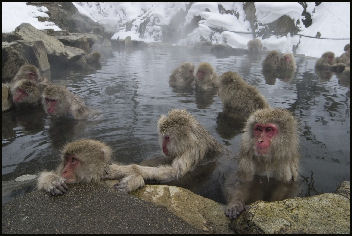
The habit that some snow monkeys have of seeking respite from the winter cold by sitting in hot springs is a behavioral trait that has also been passed on. The habit began with a troupe of monkeys that lived in the mountains in northern Honshu began using a hot spring used by humans. As they extended their range they discovered some volcanic hot springs. First only a few took a bath in the warm water. But after they tried it others did and the habit spread and became an activity that the monkeys now do every winter.
The park has no fences. The macaques are fed wheat grains and soy beans three times a day. The feeding times are 9:00am. 12:00 noon and 3:00pm. A these times the monkey come down from the mountains for hand outs from rangers. Visitors are not allowed to feed the monkeys.
There are currently two troops at the park. One has about 220 members. The other has 60. These are larger than what you would find in the wild. The smaller group usually feeds first and gives way the larger group when it approaches. The park can be reached by a half hour hike in the woods from the Kannashi Onsen bus stop. Admission is ¥500.
Websites: Jigokudani snow monkey site jigokudani-yaenkoen.co ; Zeno’s Snow Monkey Guide yudanaka-shibuonsen.com ; Wikipedia Wikipedia ;
Higashi-Kurosawa (in Minakami, Gunma Prefecture) is a center for water and mountain thrill sports such as canyoning, climbing waterfalls, tramping through streams and shooting natural water slides. trips are sponsored by the Forest & Water Company. Website: Canyons Adventures canyoning.jp
Unjo no Yu (“Bath Above the Clouds”) is the highest open-air hot spring in Japan. It is located at 2,150 meters above sea level in the Yatsugatake mountains at the foot of Minamimakimura in Nagano prefecture.
Joshin’etsukogen National Park

Mt. Asama erupting Joshin’etsukogen National Park — also known as Jo-Shin-Etsu Highland National Park — embraces a mountainous area in central Japan covered by primeval forests with white birch trees and alpine flora. It is also the home Mt. Asama and Mt. Shirane, two active volcanos, which are popular with hikers.
Joshin’etsukogen National Park covers an area of 1,4819.4 square kilometers in Gunma, Niigata, and Nagano Prefecture. It is an enormous park comprising highlands and mountains, including Mt. Tanigawa (1,977 meters), Mt. Naeba (2,145 meters), Mt. Kusatsu-Shirane (2,160 meters), Mt. Azumaya (2,354 meters), and Mt. Asama (2,568 meters). [Source: Ministry of the Environment Government of Japan]
The park includes many famous peaks that are numbered amongst the Nihon Hyakumeizan (Hundred famous mountains in Japan) — such as Mt. Tanigawa, with its towering rock slopes, and Mt. Asama and Mt. Kusatsu-Shirane, which are volcanoes — thus forming a richly varying mountain landscape. From the sides to the foot of the mountains spread cool highlands, and there are also numerous lakes and marshes. Another huge attraction of the park is the many hot springs that have been created through volcanic activity.
The park comprises high mountains with altitudes around 2,000 meters, the highest of which is Mt. Asama, and the bases of these mountains, which form highlands. Excluding the area around Mt. Tanigawa — the slopes of which are covered in large rocks, like in the Alps — most of the mountains in the park are volcanic landforms. Some of these — like Mt. Kusatsu-Shirane and Mt. Asama — have frequent eruptive activity, while others — like Mt. Naeba and Mt. Shigayama — are now extinct.
The volcanoes also vary in appearance. Mt. Naeba forms a lava highland with high moor at the peak. The Shiga Highland (Shiga Kogen) was formed by lava flows, and Shibuike Pond and other lakes located within the special protection area comprise water filling depressions in the lava rock.
The park has also been a place for mountain worship since ancient times, with pilgrims making spiritual climbs of and worshipping on Mt. Naeba, Mt. Tanigawa, and other mountains. Alongside the Yonago-Takizan Fudo-ji Okuno-in Temple, the sacred Yonako Falls have been a place for mountain spiritual training since time immemorial, and in summer Shugenja (mountaineering ascetics) can be seen performing ablutions in the water. Also, since the early days of modern mountain-climbing, the mountains in the area have been used for hiking and skiing, and Kazawa Onsen is the birthplace of the song Yukiyama Sanka (“Snowy Mountains Anthem”), which is set to the music of Oh My Darling, Clementine.
Tourism at Joshin’etsukogen National Park
The Tanigawa Mountain range in the northeast of the park is a group of mountains with alpine rocky cliffs. At the foot of the volcanos are the Shiga, Sugadari and Myoko plateaus, favored ski areas. There are also a number of spas and lakes, which offer fishing in the summer and skating in the winter. Website: Government National Park Site National Parks of Japan
Karuizawa (southern entrance of Joshin’etsukogen National Park) is popular summer retreat for wealthy Tokyoites. Located at an elevation of 3,000 feet, it offers a number of recreation opportunities and expensive hotels. Ever since foreigners began coming here to escape the summer heat during the Meiji period, Karuizawa has developed as a representative Japanese summer retreat. John Lennon and Yoko Ono spent several summers at the Mampei Hotel in Karuizawa. Karuizawa is also a jumping off point for Mt. Asama. The National Karuizawa Wild Bird Forest is said to be home to 120-130 bird species. Websites:Karuizawa Town site visitkaruizawa.com ; Japan Guide japan-guide.com Ryokan and Minshuku Japanese Guest Houses Japanese Guest Houses Budget Accommodation: Japan Youth Hostels Japan Youth Hostels Check Lonely Planet books Getting There: Karuizawa is accessible by bus and train. It is only a two hour train ride from Tokyo’s Ueno Station.
Accommodation Areas: Shima Onsen, Manza, Kazawa, Kusatsu, Mt. Tanigawadake, Shiga Highland (Shiga-Kogen), Sugadaira Highland (Sugadaira-Kogen), Yujyuku Onsen, Kawafuru Onsen, Houshi Onsen. Eco Tours are organized in Minakami Town. The tours enable visitors to enjoy the beautiful nature of Mt. Tanigawa while preserving the environment and passing it down to future generations. Eco tours led by guides with a thorough knowledge of Mt. Tanigawa enable visitors to more deeply experience the appeal of Mt. Tanigawa and enjoy fulfilling nature observations and nature walks. Skiing can be enjoyed at Shiga Highland and Naeba ski slopes. Visited by large numbers of skiers in the winter season. The first ski lift in Honshu was constructed at the Shiga Highland site.
Getting There: 1) From Tokyo Station take the Hokuriku Shinkansen Joetsu Shinkansen about 55 minutes to get to Takasaki Station. From there take JR Joetsu Line about 85 minutes to get to Naganohara-kusatsuguchi Station. From there take JR Kanto Bus about 30 minutes to get to Kusatsu Onsen Bus Terminal. 2) From Tokyo Station take the Hokuriku Shinkansen about one hour 20 minutes to get to Nagano Station. From there take Nagaden Bus about 60 minutes to get to Shigakogen Hasuike (Hasuike Pond in Shiga Highland). 3) From Tokyo Station take the Joetsu Shinkansen about one hour 10 minutes to get to Jomokogen Station. From there take Kan-etsu Transportation Bus about 50 minutes to get to Tanigawadake Ropeway. 4) From Tokyo Station take the Joetsu Shinkansen about one hour 10 minutes to get to Echigo-Yuzawa Station. From there take Taxi about 40 minutes to get to Mt. Naeba Trail Head (Wadagoya)
Tourism Information at Joshin’etsukogen National Park
Kazawa Information Center is a facility providing a picnic site and a range of information on the natural environment. Also has a visitors salon and a multi-purpose building housing 50 people. The conditions in the woods can be observed from the 'Limpid Stream Pathway' and the 'Maple Tree Pathway.' Volunteers hold nature observation meetings throughout the four seasons. Location: Kazawa Picnic Site, Tashiro, Tsumagoi Village, Agatsuma County, Gunma Prefecture, Tel: 0279-80-9119; Hours Open: 9:00am-4:30pm, Closed Open daily (open Friday, Saturday, Sunday from December through March)
Sugadaira-Kogen Natural Museum is a facility that exhibits the history and natural environment of the Sugadaira Highland. Exhibits include a variety of dioramas and samples covering life in the area in ancient times, and the plants, insects, and small animals of the Sugadaira Highland. The Sugadaira Marsh, expanding in the surrounding areas, includes nature trails for observation of plentiful vegetation and small birds. Location: Sugadaira-Kogen 1223-2276, Ueda City, Nagano Prefecture, Tel: 0268-74-2438; Hours Open: May holidays, June-September 9:00am-16:00, Closed Tuesdays, October-May (however open during May holidays) Admission: General 200 yen (160 yen), primary, middle and high school students 100 yen (80 yen)
Yunomaru Nature Study Center is located in the Jizo-Toge Pass at the entrance to the Yunomaru Highland. Characterized by roofs suggesting the pointed Mt. Eboshi and the rounded Mt. Yunomaru. The four seasons of Yunomaru and plant and animal life are displayed on a 100-inch screen and on monitor TVs. A diorama of the entire Yunomaru area is provided to explain trekking routes, etc. Location: Yunomaru-Kogen, Tomi City, Nagano Prefecture, Tel: 0268-62-4333; Hours Open: 9:00am-16:00, Closed Wednesdays
Shigakogen Nature Protection Center is located in the Shigakogen Sogo Kaikan 98 which is near Shigakogen Hasuike. Provides easy-to-understand explanations of the forests and marshlands and background to the natural environment, of the Shiga Highland based on the themes of Shiga Highland Nature Guide, A One-point Nature Observation Lesson, Life in the Shiga Highland, and Sight-seeing in the Shiga Highland. A guides' association has been established. Location: Shigakogen Hasuike, Yamanouchi Town, Shimotakai County, Nagano Prefecture, Tel: 0269-34-2133; Hours Open: 9:00am-5:00pm (winter 9:00am-16:00), Closed Open daily throughout the year
Tanigawadake Mountain Archives exhibits a wide range of information on Mt. Tanigawa collected from throughout Japan. Also includes photos of the animals and alpine plant life on Mt. Tanigawa. Visit when climbing Mt. Tanigawa, and when trekking at Ichinokurasawa. Location: Yubukiyama, Yubiso, Minakami Town, Tone County, Gumma Prefecture, Tel: 0278-72-6446; Hours Open: 9:00am-4:30pm, Closed Thursdays, winter
Animals and Plants at Joshin’etsukogen National Park
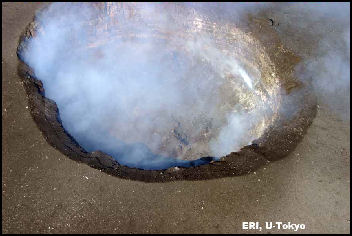
Mt. Asama crater The mountains in Joshin’etsukogen National Park are covered in forests of Japanese beech and other broadleaf deciduous trees up to an altitude of around 1,500 meters; at higher altitudes, subalpine coniferous forests of Japanese hemlock and Maries' fir can generally be seen. In addition, many mountains in the park have unique plant life due to differences in topography, the periods in which landforms were created through volcanic activity, and the heavy snowfall during winter. [Source: Ministry of the Environment Government of Japan]
Low trees and shrubs such as mountain ash, heathberry, and bog whortleberry can be seen on still-active volcanoes such as Mt. Kusatsu-Shirane, where forests do not grow. On Mt. Kusatsu-Shirane and the Shiga Highland (Shiga Kogen), Siberian dwarf pine grows even at altitudes of 2,000 meters or less, and alpine floras can be seen on the scree slopes characteristic of volcanoes. Many of the high moors and lakes on Mt. Naeba and the Shiga Highland (Shiga Kogen) developed in the uneven surfaces of lava rock and other volcanic ejecta, and the park has a diverse range of flora, including Scirpus hotarui communities.
In this park, it is possible to see various plants that are peculiar to mountains and highlands. In particular, the alpine floras growing in subalpine belt, flowers blooming in wetland areas, and Japanese azalea growing on the Yunomaru Highland in particular are all very well-known, and many people visit the park to see them. At Ikenotaira Marsh various flowers can be viewed all year round, including Irises and Dicentra peregrina in July, rosebay in August, and Gypsy Rose in autumn. Footpaths have been provided, enabling visitors with no mountain climbing experience to easily enjoy the landscape.
Mammals living in the park area include black bears, Japanese serow, Japanese monkeys, Japanese squirrels, Japanese stoats and dormice. Among the bird species are golden eagles, mountain hawk-eagles, and other birds of prey, as well as spotted nutcrackers and house martins. Insect species living in the park include various rare alpine butterflies such as Erebia niphonica.
Golden Eagle (Aquila chrysaetos japonica) is a large bird of prey found in mountainous regions of Japan from Hokkaido to Kyushu. This park is characterized by a diverse natural environment and steep terrain, suited to the golden eagle in its position at the top of the ecological system.
Japanese Stoat (Mustela ermine a nippon) is species of the weasel family. Found in the subalpine zone (above 1,500 meters) in the central region of Honshu and further north. Its coloring changes from a dark brown on the back and white underparts in summer, to overall white with a black tip of the tail in winter. The 'Okomin' character used in tourism PR for the Shiga Highland is derived from this animal.
Japanese Serow (Capricornis crispus) is an unusual, goat-like, even-toed ungulate mammal that can be found in the mountainous regions of Honshu, Shikoku and Kyushu. The animal has been designated a Special Natural Monument. Their wide hooves allow them to easily climb up steep slopes. Mountain climbers and other visitors to Joshin'etsukogen National Park may encounter them in the wild.
Volcanoes and Mountains in Joshin’etsukogen National Park
Mt. Kusatsu-Shirane ( west of Kusatsu hot springs in Gunma Prefecture) is 2,160-meter-high (7,087-foot-high) volcano. A number of crater lakes have formed at the top of the mountain. Yugama is the largest among them with 300 meters in diameter and 30 meters in depth, and it is one of the world's few acidic lakes. The volcanic warning level is currently increasing, and passage is restricted in some sections. Mt. Kusatsu-Shirane has a distinctive landscape in which the blue-green Yugama Crater Lake and surrounding volcanic desert contrasts with the surrounds volcanic desert. Mt. Azumaya is a stratovolcano, and Sugadaira, which spreads out on the eastside of the base of the mountain, is a highland formed by lava flow from Mt. Azumaya. Japan Meteorological Agency | jma.go.jp/en/volcano/map
Mt. Naeba area is world famous as a heavy snow area. The foot of the mountain is covered with expansive Japanese beech forests, while the broad marshes covering the peak of Mt. Naeba are dotted with countless ponds surrounded by multitudes of blooming flowers.
Tanigawa Moutain Range comprises Mt. Tanigawa, Mt. Shigekura, Mt. Mantaro, Mt. Tairappyo, and other non-volcanic mountains in the 2,000 meters altitude range. Ichinokurasawa Gorge is said to be one of Japan's three greatest rock faces, and is a rock-climbing Mecca. Using the ropeway and lifts provides a relatively easy way to view the Tanigawa Moutain Range.
Shiga Highland (Shiga Kogen) is a complex landform created by vigorous volcanic mountain-building activities. Scattered around the highland are close to 70 marshes and lakes/marshes, both large and small, represented by Onuma Pond, Shichijuhachi-ike Marsh, and Chigo-ike Pond. The Shiga Highland (Shiga Kogen) was developed as one of Japan's top ski resorts, but in striking contrast to this image, the alpine areas are covered in primeval forest thick with Japanese hemlock, Maries' Fir, Japanese Thuja, and other conifers, presenting a diverse range of expressions.
Chigo-ike Pond (Mt. Yakebitai) is pond surrounded by the high moor at the top of Mt. Yakebitai in the Shiga Highland. A variety of flowers bloom around the moor depending on the season. Frogs and salamanders are also found here. Primordial forests of Maries' fir and Tsuga diversifolia remain around the moor.
Mt. Nekodake is a 2,207-meter-high (6,650 foot-high) mountain located on the boundary between Ueda City and Suzaka City in Nagano Prefecture. It and the adjacent Mt. Azumaya are famous for the flowers and colors between spring and fall.
Onsens in Joshin’etsukogen National Park
With its concentration of volcanoes, Joshin’etsukogen National Park has an abundance of hot springs and is dotted with ancient hot spring districts — such as Shima Onsen, Kusatsu Onsen, Manza Onsesn, Kazawa Onsen, and Yamada Onsen — that have been frequented by numerous famous writers and artists over their long histories.
Shima Onsen has been known as a hot springs area since ancient times. It features a retro townscape appropriate for the "Inner Room of the Kanto Region." The hot springs town has been created within a rich natural environment enclosed by the mountains lining the Shima River. (The first hot springs area in Japan designated as a "People's Recreation Spa.")
Manza Onsen is a hot spring village located on a highland (1,800 meters). The hot springs have been renowned since ancient times for the abundant amount of spring water. Here it is possible to experience nature through the changing seasons, enjoying the residual snow and new leaves in spring, escaping the summer heat in summer, viewing the vividly colored foliage in autumn, and enjoying skiing in winter.
Kusatsu Onsen is a representative Japanese hot springs area. The famous hot springs district — centered around Yubatake — has an old-world flavor. Sainokawara Park is a national park where hot springs bubble up from various spots in the riverbed, creating a flowing river of hot water.
Kusatsu Visitor Center is a facility using photos and videos, and display panels to explain the relationship between the volcanoes and hot springs surrounding Kusatsu, the distribution of plant and animal life around Mt. Shirane, and the history of the area. Kusatsu is well-known as a town of hot springs; however, the facility also provides opportunities to learn about the expansive natural environment of the area. Pay a quick visit while on the nature trail in the Sainokawara Park. Location: Sainokawara, Kusatsu Town, Agatsuma County, Gunma Prefecture, Tel: 0279-88-5705; Hours Open: 9:00am-16:00, Closed Thursdays and second Tuesday of each month, and end and beginning of year (open daily in July, August, September)
Kazawa Onsen- Yunomaru Highland is famous for its hot springs and flowers. In Yunomaru Highland, you can see a vast community of over 600,000 Japanese azalea shrubs, which are ablaze with flowers in early summer. At the base of the mountain are the Kazawa Onsen and Shin-Kazawa Onsen.
Mt. Asama
Mt. Asama (35 kilometers southeast of Nagano as the crow flies, on the border of Gunma and Nagano Prefectures) is a very active 2568-meter-high composite volcano that has erupted at least 50 times and has a large eruption every four or five centuries. In 1783, pyroclastic flows killed 1,151 people. In 1911 there were sporadic eruptions with numerous deaths. In 1930s there was some volcanic activity. Six died near the crater in 1930. There were three more deaths in 1931. In 1947, 11 mountaineers died after being hit by rocks and cinders from an eruption. In 1721 the same thing happened to 15 mountain climbers
Mt. Asama is one of Japan's representative volcanoes and to erupt and sends up plumes of smoke regularly. At the northern foot of the mountain is a place of scenic beauty formed by lava rocks being pushed upwards. There is a vast field of lava rock known as Onioshidashi ("Push out the Devils"). Takamine Highland, a base for skiing and mountain climbing. It hot springs are also popular. The summit area of Asama is often closed due to worries about eruptions. Sometimes an area within a four kilometer radius is closed off and guards are posted on the trails to turn back hikers. Hikers can explore some major lave flows though. Websites: Japan Meteorological Agency | jma.go.jp/en/volcano/map; Wikipedia Wikipedia Asama Volcano Museum (Japanese language site) asamaen.tsumagoi.gunma.jp
Asama Volcano Museum brings the experience of the power of the volcano. Sound and video are used to bring a subterranean experience in the 'Subterranean Research Vessel' and 'Lost World' entertainment zones, and geology and natural environment exhibits explain the structure of a volcano, and the natural environment of the Asama volcano. Location: Kita-karuizawa, Naganohara Town, Agatsuma County, Gunma Prefecture, Tel: 0279-86-3000; Hours Open: 8:30am-5:15pm, Closed December-March Admission: Requires a fee
Takamine-Kogen Visitor Center is a center for sight-seeing in the entire Asamasanroku (the foot of Mt. Asama) area. Staff of the Asama International Outdoors and Nature School (NPO) are stationed here. The information center provides information on sight-seeing and mountaineering in the foot of Mt. Asama. Meals created from local ingredients are available at the cafe-restaurant. Location: Takamine-Kogen, Komoro City, Nagano Prefecture, Tel: 0267-23-3214; Hours Open: 8:00-5:00pm, Closed Open daily throughout the year
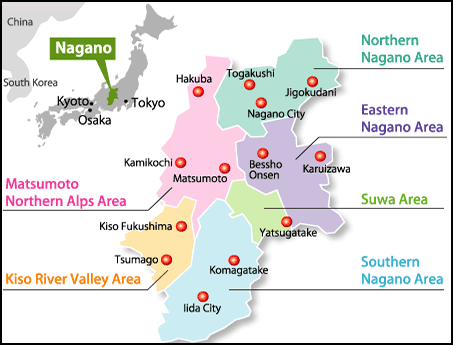
Recent Eruptions of Mt. Asama
In 1973, Asama erupted after being dormant for more than 11 years. Scientists recorded 4,000 small explosions in a four month period. Eruption in 1982 and 1983 sent ash beyond Tokyo Bay to the Boso Peninsula. There were minor eruptions with some ash fall in 1990 and again in April 2003. Today, tourists check out the blocks of solidified lava produced by eruptions in the Edo period in the 17th to 19th centuries.
Asama came to life in 2004, with four mid-size eruptions between September and November. Smoke and ash was hurled more than a mile into the sky, falling on Tokyo 90 miles away, and damaged crops in the vicinity of the volcano. Hundreds of tremors were recorded. Shocks from the eruption blew out windows at the Asama Volcano Museum near the base of the mountain, set off some forest fires, and forced the evacuation of some houses. A farm 20 kilometers north of the crater was hit by a shower of rocks. No one was hurt.
Minor eruptions continued for several days, Lava spewed out the crater in fountains and poured down the slopes. A magma dome — the first since 1982 — was formed. In December 2004, Asama was releasing 2,000 to 4,000 tons of gas a day and lava could be seen at the bottom of the crater.
Asama erupted off and on until June 2005. A huge andosite boulder that was five meters tall and 5 meters deep and weighed 200 to 300 tons was ejected and came to rest about 200 meters from the crater. Scientist think it was part of a lid at the bottom of the crater that was smashed during the eruption. The boulder flew 170 meters, bounced once, leaving a 13-meter wide hole, rolled a little further and stopped.
Mt. Asama experienced a minor eruption in February 2009.. Smoke billowed more than 2,000 meters into the air and rocks were thrown more than a kilometer from the crater. Ash fell as far as central Tokyo and Chiba Prefecture. A warning of an eruption was issued two days before after swelling at the top of the volcano was detected and people were told not go within four kilometers of the crater. There was a small eruption in June, 2015. Scientists say there is a possibility of large eruption in the not too distant future as magma has accumulated in shallow area near the peak.
Image Sources: 1) Nagano Prefecture tourism map 2) 3) JNTO 4) 7) Nagano City 5) 8) Matsumoto City 6) Kamikochi site 9) Onsen Express, 10) 11) 12) Tateyama-Kurobe Route site 13), 14) Volcano Research Venter Univerity of Tokyo, 15) 16) 17) Nagagono Prefecture 18) Snow Japan Wikipedia, 16) Matsumoto City, 19) JNTO
Text Sources: JNTO (Japan National Tourist Organization), Japan.org, Japan News, Japan Times, Yomiuri Shimbun, Japan Ministry of the Environment, UNESCO, Japan Guide website, Lonely Planet guides, New York Times, Washington Post, Los Angeles Times, National Geographic, The New Yorker, Bloomberg, Reuters, Associated Press, AFP, Compton's Encyclopedia and various books and other publications.
Last Updated in December 2024
